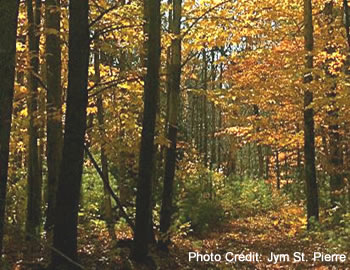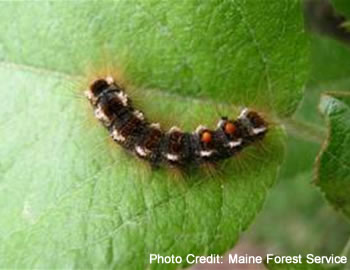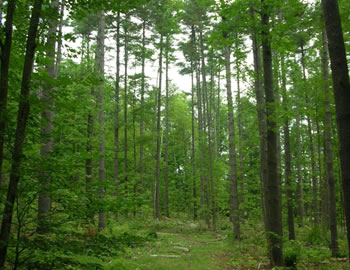Home → Your Woodland → Learn What You Can Do for Kennebec County's Woodlands → A Stewardship Storyline →How can I keep my woodland healthy?
Your Woodland: A Stewardship Storyline
How can I keep my woodland healthy?
Many landowners strive to keep their woodlands healthy. However, health can mean different things from the forest's perspective. For instance, most forests have some dead or declining trees that provide important habitat for birds, insects, salamanders, and other wildlife. Dead logs and branches also return nutrients to the soil.
There are many types of native insects and diseases that affect trees in Maine's forests. A number of them exist at low levels and, while they may damage or kill a few trees, they are part of the forest ecosystem and not a threat to the whole forest. Windstorms, ice storms, and other events can also affect parts of your woodland.
In some forests, health can be improved by applying a silvicultural technique such as thinning the forest to make the remaining trees more vigorous and resistant to natural disturbances. Silviculture is the art and science of decision-making in forest management. It is based on the science of silvics, the study of how and why trees grow the way they do. Foresters are trained in silviculture. They can help you understand your woodland and identify steps that can be taken to keep your woodland healthy.
Would you like to learn more?
Contact a Maine licensed forester about evaluating your woodland's health.
Contact your Maine Forest Service District Forester about visiting your property.
Sign up for the MFS Insect & Disease email reports.
To learn more about silviculture, visit the Good Forestry in the Granite State website.
Read about Focus Species Forestry: A Guide to Integrating Timber and Biodiversity Management in Maine
Read and watch videos about Maine's black bears.
Learn about the importance of young forest wildlife habitat.
Read the guide, Under cover: Wildlife of Shrublands and Young Forest.
The Maine Natural Areas Program (MNAP), within the Maine Department of Agriculture, Conservation and Forestry, serves's citizens as the most comprehensive source on the State's important natural features. With landowner permission, the Program inventories lands that support rare and endangered plants, rare natural communities and ecosystems, and outstanding examples of more common natural communities and ecosystems.MNAP frequently responds to requests for use of MNAP's and MDIFW's natural resource data inplans and other land management projects.
Read the USDA Forest Service series "The Biodiversity of a New England Woodlot" at http://na.fs.fed.us/stewardship/pubs/pubs.shtm
Read about the economic benefits of protecting healthy watersheds.
Would you like to talk with a person about this stewardship step? Here are some partners who can help:


